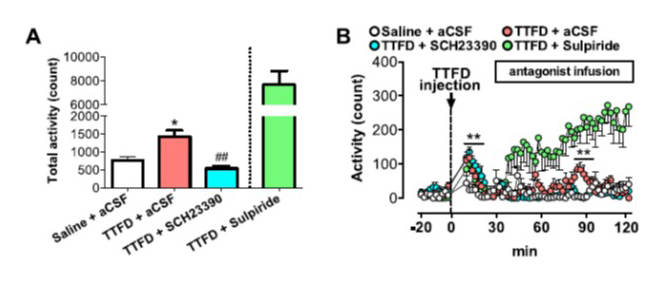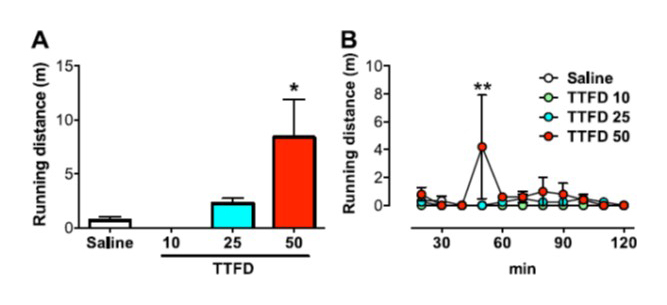Novel effect of thiamine tetrahydrofurfuryl disulfide in promoting voluntary physical activity - Involvement of dopamine
- August 3, 2018
Takeda Consumer Healthcare Company Limited , (“Takeda”) hereby announce that we have found, through joint research with the University of Tsukuba, that Fursultiamine (thiamine tetrahydrofurfuryl disulfide: TTFD), vitamin B1 derivative enhances voluntary physical activity.
The results of this study were published in the online science journal Scientific Reports on July 11.*
Physical activity, which involves exercise and daily-life activities, is effective in maintaining and improving physical and mental fitness; however, it appears difficult to continue engaging in such activities.
Our convenient lifestyle causes a lack of exercise and a reduction in daily number of steps taken. Inactivity leads to the lack of vitality in the body and mind, and it is becoming a social issue.
Measures to enhance the motivation for exercise and improve daily physical activity are required in modern human society.
In this study, we investigated voluntary locomotor activity and dopamine levels in the frontal lobe (particularly in the medial prefrontal cortex) after administering TTFD to rats using in vivo microdialysis, which enabled us to quantify the neurotransmitter levels in the brain while measuring locomotor activity.
The results revealed that TTFD-enhanced locomotor activity in rats was synchronized with dopamine release in the medial prefrontal cortex (Fig. 1).
Subsequently, we administered antagonists of dopamine receptors (D1 receptor antagonist: SCH23390, D2 receptor antagonist: sulpiride) to the medial prefrontal cortex and examined the involvement of dopamine receptors in TTFD-enhanced locomotor activity.
The results suggested that TTFD-enhanced locomotor activity was promoted via the dopamine D1 receptor in the medial prefrontal cortex, because inhibition of the dopamine D1 receptor suppressed TTFD-enhanced locomotor activity (Fig. 2).
Finally, we examined the running distance after administering TTFD using a running-wheel cage to investigate the effect of TTFD on running exercise and found a dose-dependent increase in voluntary wheel running (Fig. 3).
These results indicate that TTFD increases dopamine release in the medial prefrontal cortex and enhances voluntary locomotor activity via the dopamine D1 receptor.
The results of this study suggest the novel potential of TTFD for promoting voluntary physical activity and helping in the maintenance and improvement of physical and mental fitness.
In the future, the results of this study will be widely expected to have an impact on various applications including recovery from or prevention of fatigue.
We will continue to study TTFD in the future.
* Thiamine tetrahydrofurfuryl disulfide promotes voluntary activity through dopaminergic activation in the medial prefrontal cortex
Masato Saiki1, Takashi Matsui1,2, Mariko Soya1,Tomomi Kashibe1, Takeru Shima1, Takeshi Shimizu3, Takehiro Naruto4, Takahito Kitayoshi4, Kouji Akimoto4, Shinji Ninomiya4 and Hideaki Soya1,2
1Laboratory of Exercise Biochemistry and Neuroendocrinology, Faculty of Health and Sport Sciences, University of Tsukuba.
2Sports Neuroscience Division, Advanced Research Initiative for Human High Performance (ARIHHP), University of Tsukuba.
3Sports Research and Development Core, University of Tsukuba.
4Takeda Consumer Healthcare Company Limited.
Scientific Reports
DOI: 10.1038/s41598-018-28462-2
https://www.nature.com/articles/s41598-018-28462-2

Fig. 1
TTFD induces voluntary locomotion and dopamine release in the prelimbic cortex.
(A) Total voluntary activity in a normal cage. (B) Voluntary activity in a normal cage for 120 min.
(C) Extracellular dopamine levels. (D) Extracellular serotonin levels.
*P < 0.05; **P < 0.01 versus saline group.

Fig. 2
Dopamine D1 receptor antagonist (SCH23390), but not D2 receptor antagonist (sulpiride), inhibits TTFD-induced voluntary locomotor activity.
(A) Total voluntary activity in a normal cage. *P < 0.05 versus saline + aCSF group, ##P < 0.01 versus TTFD + aCSF group.
(B) Voluntary activity in a normal cage for 120 min. **P < 0.01 versus saline + aCSF group.

Fig. 3
TTFD increases voluntary running distance in a dose-dependent manner in running-wheel cage.
(A) Total running distance in a running-wheel cage. *P < 0.05 versus TTFD 10 mg/kg group.
(B) Running distance in a running wheel cage for 120 min. **P < 0.01 versus saline group.
